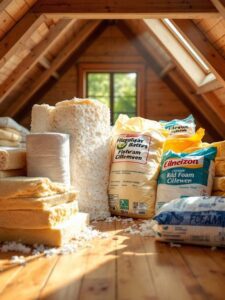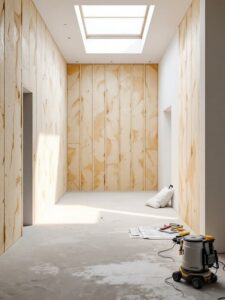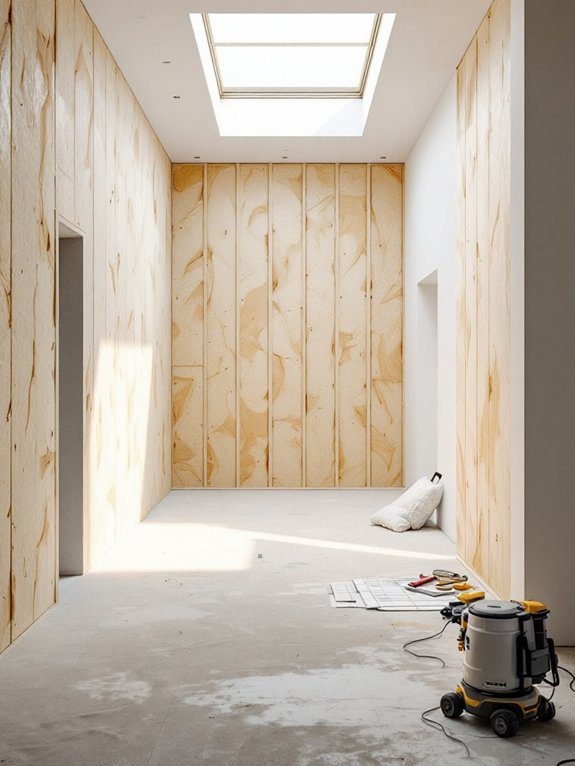You don’t need to be on benefits to get free loft insulation through the Great British Insulation Scheme (GBIS). You’ll qualify if your home has an EPC rating of D or below, your existing insulation is less than 100mm thick, and you’re in council tax bands A-D in England (A-E in Scotland/Wales). Your household income should be under £31,000 annually. You can start with a simple online eligibility check or call 0800 098 7950 to explore your options further.
Key Takeaways
- Properties with EPC ratings of D or below can qualify for free insulation through the Great British Insulation Scheme.
- Households with annual income under £31,000 can access free insulation even without receiving benefits.
- Properties in council tax bands A-D in England or A-E in Scotland/Wales may qualify regardless of benefit status.
- Homes with less than 100mm of existing loft insulation are prioritized for free installation.
- Those with qualifying health conditions or disabilities affecting cold sensitivity can access free insulation through specialized pathways.
Understanding the Great British Insulation Scheme (GBIS)
While many homeowners struggle with rising energy costs, the Great British Insulation Scheme (GBIS) offers a practical solution through free or subsidized home insulation.
You’ll be pleased to know that GBIS targets homes with EPC ratings of D or below, making energy efficiency improvements accessible to more households across Great Britain.
The scheme’s insulation benefits extend beyond just loft installations. You can access cavity wall, solid wall, roof, and underfloor insulation options, depending on your property’s needs. Properties with minimal existing insulation of less than 100mm thickness are particularly encouraged to apply. With potential savings of up to £650 annually on energy bills, the investment in insulation quickly pays for itself.
Transform your home’s comfort with comprehensive insulation solutions, from cavity walls to underfloor protection – all tailored to your property’s requirements.
If you live in a council tax band A-D property in England, or A-E in Scotland and Wales, you’re potentially eligible. You don’t even need to be on benefits to qualify, and you can check your eligibility through the government portal or participating energy suppliers.
Income-Based Eligibility Routes
If you’re looking to secure free loft insulation through income-based programs, several routes can help you qualify.
The ECO4 scheme offers coverage if your household’s annual income is £31,000 or less, even without benefits. You’ll need to complete an income verification process through a simple assessment form.
Your local authority might offer additional options through the LA Flex program, which considers factors beyond just income. The new Great British Insulation Scheme is specifically designed for households not receiving government support.
Even if you don’t meet the standard eligibility criteria, you could qualify based on your area’s specific initiatives or your home’s energy performance rating.
The process typically starts with a free assessment, followed by a visit from certified installers.
Properties with less than 100mm of existing loft insulation are typically prioritized for these schemes.
Council Tax Band Qualification Options
Qualifying for free loft insulation through council tax bands offers a straightforward path to energy-saving benefits.
You’ll find different eligibility criteria depending on where you live in the UK, with support available across various council tax bands.
- If you’re in England, you can qualify if your home is in council tax bands A to D.
- Scottish and Welsh residents have broader eligibility, covering council tax bands A to E.
- Your local authority might offer additional support through LA Flex schemes, even if you’re in a higher band.
- You’ll need to provide proof of your council tax band during the application process.
- Local initiatives often work alongside national programs, so you might have multiple qualification routes available.
Through the ECO4 scheme, you can receive full coverage for insulation up to the recommended depth.
Check your council tax band and contact your local authority to explore all available options for free insulation support.
Your household income must be under £31,000 per year to be considered eligible for these council tax band-based schemes.
EPC Rating Assessment and Requirements
Understanding your home’s EPC rating is essential when seeking free loft insulation, as your property’s energy efficiency directly affects your eligibility for grants. Your EPC must be valid within the last 10 years, rating your home from ‘A’ (most efficient) to ‘G’ (least efficient).
An EPC rating between A and G determines your home’s energy efficiency and eligibility for free insulation grants.
To implement effective EPC compliance strategies, you’ll need to focus on key areas like insulation, heating systems, and lighting. Properties require 69 to 80 points on the Standard Assessment Procedure to achieve a C rating.
While there’s currently no legal requirement to make all recommended improvements, energy efficiency upgrades will become increasingly important as regulations tighten. By 2028, rental properties must achieve a ‘C’ rating, and similar standards may apply to all homes in the future.
Getting your loft insulated now could greatly improve your EPC rating and position you better for upcoming regulations while reducing your energy bills. Upgrading to 270mm thickness insulation is the recommended standard for maximizing energy efficiency in your home.
Local Authority Support Programs
Once you’ve assessed your EPC rating, local authority support programs offer another promising path to free loft insulation.
Through local authority initiatives and community outreach programs like LA Flex, you can access support even if you’re not receiving traditional benefits. Your council may consider factors like energy debt, health conditions, or specific regional challenges when determining eligibility. With proper installation helping to prevent up to 25% heat loss through your roof, these programs can significantly impact your home’s energy efficiency. Depending on your property type, installations can cost between £654 to £1,206 for a complete service.
- Local councils set their own criteria, making support more accessible to households with unique circumstances.
- You don’t need to be on benefits – income assessment and energy efficiency needs are key factors.
- Your energy supplier or mortgage provider might refer you to these programs.
- Home assessments help determine the extent of insulation needed.
- Local authority schemes often provide full funding for qualifying households.
Contact your local council to learn about available programs and eligibility requirements in your area.
Alternative Schemes for Homeowners
Several government-backed schemes offer homeowners free or subsidized loft insulation without requiring benefit eligibility. You’ll find alternative funding through programs like the Great British Insulation Scheme (GBIS) and ECO4’s flexible criteria. These initiatives focus on improving your home’s energy efficiency while keeping costs down.
| Scheme Name | Key Benefits |
|---|---|
| GBIS | Free loft insulation for non-benefit households |
| ECO4 | Flexible eligibility criteria |
| Home Upgrade Grant | Extensive energy upgrades |
| Warmer Homes Scotland | Scotland-specific support |
To qualify, your property typically needs an EPC rating of D or below, and you’ll need to meet specific council tax band requirements. Your loft must be accessible and have minimal existing insulation. These schemes can help you save up to £370 annually while making your home more comfortable and environmentally friendly. With standard quilt insulation starting at £10 per square metre, these programs offer significant financial relief for homeowners.
Health and Disability Pathways
People with health conditions or disabilities can access specialized pathways to receive free loft insulation through various government schemes.
If you’ve got a medical condition that’s worsened by cold or poorly insulated environments, you might qualify for free installation. You’ll need to provide medical documentation to support your application, and eligibility is assessed case-by-case.
- Respiratory conditions like asthma may qualify you for priority insulation support
- Your local authority can evaluate your health needs for insulation benefits
- ECO4 and the Great British Insulation Scheme offer disability-based support
- Medical assessments help prove your eligibility for health-related grants
- Proper insulation can greatly improve your living environment by maintaining consistent temperatures
Installing 270mm of insulation can help reduce heat loss by up to 25%, making it especially beneficial for those with health conditions.
Application Process and Required Documentation
The application process for free loft insulation starts with a simple online eligibility check through your energy supplier or the government website. You’ll need to gather specific documentation for a smooth application overview, and you can either apply online or call the dedicated helpline at 0800 098 7950. Eligible households can save up to £250 per day on professional installation costs through available government grants.
Documentation Checklist | When It’s Required
—|—
Proof of ownership/rental | All applications
Income/benefit evidence | Income-based applications
EPC certificate | Energy efficiency applications
Once you’ve submitted your application, you’ll be contacted to arrange a home assessment. The entire process is designed to be straightforward, and you’ll have support throughout each step. Remember to keep all your paperwork organized and readily available, as this will help speed up your application. Your energy supplier will guide you through any additional requirements specific to your chosen scheme.
Frequently Asked Questions
How Long Does the Entire Installation Process Typically Take to Complete?
You’ll find that your loft insulation timeline varies by type. Most installations take between 2-8 hours, though larger spaces or complex jobs might extend to 1-5 days depending on your insulation choice.
Can I Store Belongings in My Loft After Insulation Is Installed?
By jove, you certainly can store items in your loft! Just guarantee you’ve installed proper loft boards above the insulation to protect its benefits. Don’t compress the material, and you’ll maintain both storage and efficiency.
What Happens if Damage Occurs to My Property During Installation?
If your property’s damaged during installation, the company’s insurance should cover repairs. Document any issues immediately, take photos, and contact your installer – they’re responsible for protecting your property during the entire process.
Will Loft Insulation Affect the Ventilation in My Home?
Properly installed loft insulation won’t block airflow. You’ll maintain ventilation balance through soffit and ridge vents, ensuring moisture control. Just make sure your installer leaves proper gaps around vents for continuous air circulation.
Do I Need to Move Out While the Insulation Is Being Installed?
You won’t need to move out during loft insulation installation. The work’s typically completed in a few hours, and temporary relocation is rarely needed. Installation safety measures guarantee you can stay comfortably in your home.
Conclusion
A penny saved on heating is truly a penny earned. While you don’t need to be on benefits to get free loft insulation, you’ll need to explore multiple routes including the GBIS, council tax band qualifications, and local authority programs. Check your EPC rating, gather necessary documents, and apply through available schemes. Don’t let cost concerns prevent you from making your home more energy-efficient and comfortable.
References
- https://www.moneysavingexpert.com/utilities/free-cavity-loft-insulation/
- https://freeinsulationscheme.org.uk/can-you-get-free-insulation-if-not-on-benefits/
- https://www.greenmatch.co.uk/insulation/grants/loft
- https://grantboilers.org.uk/blog/get-free-loft-insulation/
- https://www.freeinsulation.co.uk/who-qualifies-insulation-grants/
- https://www.greenmatch.co.uk/insulation/grants/great-british-insulation-scheme
- https://www.snugg.com/blog/the-great-british-insulation-scheme-all-you-need-to-know
- https://www.mpcenergy.co.uk/blog/can-i-get-loft-insulation-without-benefits
- https://energysavinggrants.org/can-you-get-free-loft-insulation-if-not-on-benefits/
- https://usainsulation.net/buffalo/nyserda








